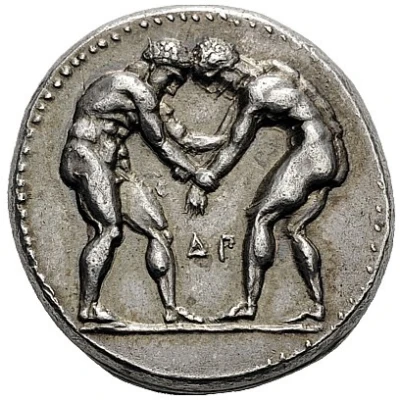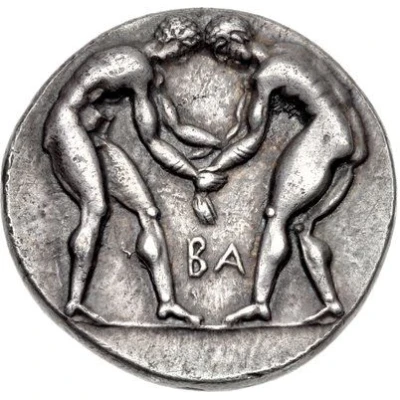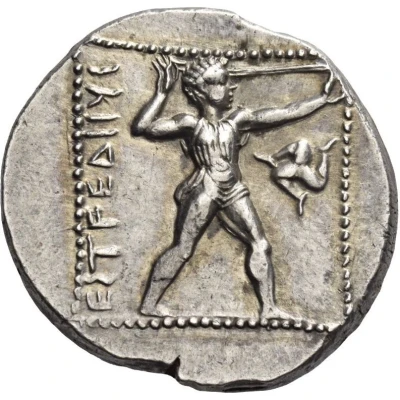


© Nomos AG
Stater 380 BC - 325 BC
| Silver | 10.96 g | 23.0 mm |
| Issuer | Aspendos (Pamphylia) |
|---|---|
| Type | Standard circulation coin |
| Years | 380 BC - 325 BC |
| Value | Silver Stater (3) |
| Currency | Drachm |
| Composition | Silver |
| Weight | 10.96 g |
| Diameter | 23.0 mm |
| Shape | Round (irregular) |
| Technique | Hammered |
| Demonetized | Yes |
| Updated | 2024-10-10 |
| Numista | N#185342 |
|---|---|
| Rarity index | 95% |
Reverse
Slinger striding right, preparing to launch sling-bolt. To right, triskeles to left above an uncertain symbol, perhaps a greave and all within rectangular frame of pearls
Script: Greek
Lettering: ΕΣΤFΕΔΙΙΥΣ
Translation: Aspendos
Comment
Comment from Roma Numismatics:"Coins depicting a pair of wrestlers were first issued by Aspendos beginning circa 400 BC, and continued to be struck until they were replaced by Alexander's 'universal' currency in the 320s. These wrestler coins replaced the earlier types, which had generally featured a militaristic obverse depicting a hoplite warrior or cavalryman, with a triskeles or boar upon the reverse.
The wrestler coins may seemingly be divided into two broad groups: the first, clearly minted earlier, shows a great deal of variation in the posture of the wrestlers; the second shows the wrestlers always in the same stances. This second group was in all probability inaugurated by an issue (von Aulock 4568) bearing the inscription MENETΥΣ EΛΥΨA, which Hill (NC 1920, pp. 115-116) interprets as the names of the two wrestlers: Menetos and Elypsa. The obvious conclusion is that the wrestlers depicted represent a commemorative statue group erected at Aspendos, with the first group of coins struck after the event commemorated, but before it was set in stone, and the second group with its unchanging stances being struck after the completion of the statue group. The reason for such a work is uncertain however. It is possible that one of Apendos' citizens was victorious at the Olympic games, since such victories are believed to have inspired coin types on more than one occasion (at Messana and on Philipp II of Macedon's coinage). It is also known however that games were instituted at Aspendos in 402 BC, and that they represented a revival of an earlier festival. In any case, the prominence of this type, which endured on their coins for over a century, suggests it was of particular significance to the city, and the importance of this coinage in the region was such that the city of Selge in Pisidia issued a series of its own staters in the 4th century that clearly imitated Aspendos' coinage."
Interesting fact
One interesting fact about this coin is that it features the image of a lion, which was a symbol of power and strength in ancient Pamphylia. The lion was also associated with the god Apollo, who was revered in Aspendos, and the coin may have been used as a form of offering to the deity. Additionally, the coin's design and weight conform to the standardized currency system used throughout the ancient Greek world, indicating the extent of trade and economic exchange networks in the region during that time.



